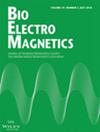Gernot Schmid, Pia Schneeweiss, Rene Hirtl, Johannes Kainz, Cornelia Sauter, Heidi Danker-Hopfe, Hans Dorn
求助PDF
{"title":"Design and Dosimetric Analysis of a Whole-Body Exposure Setup for Investigating Possible Effects of 50 Hz Magnetic Fields on Sleep and Markers of Alzheimer's Disease","authors":"Gernot Schmid, Pia Schneeweiss, Rene Hirtl, Johannes Kainz, Cornelia Sauter, Heidi Danker-Hopfe, Hans Dorn","doi":"10.1002/bem.70022","DOIUrl":null,"url":null,"abstract":"<div>\n \n <p>A new whole-body exposure facility for a randomized, double-blind, cross-over provocation study investigating possible effects of 50 Hz magnetic field exposure on sleep and markers of Alzheimer's disease has been developed and dosimetrically analyzed. The exposure facility was custom-tailored for the sleep laboratory where the study was carried out and enables magnetic flux densities of up to 30 μT with a maximum field inhomogeneity of less than ± 20%. Exposure is applied fully software-controlled and in a blinded and randomized manner. The orientation of the applied magnetic field vector is varied by the control software to create a uniformly distributed set of field vector orientations throughout each experimental session. A numerical dosimetric analysis of the exposure facility was carried out using several high-resolution anatomical body models. Induced electric field strengths in the range of 0.5–0.6 mV/m (99.9th percentile of 2 × 2 × 2 mm<sup>3</sup> averaged induced electric field strength <i>E<sub>i</sub></i>) inside the brain at an external exposure level of 30 μT were obtained for magnetic field vector orientations along the three main axes (front-back, left-right, head-feet). Statistics of volume averaged values of <i>E<sub>i</sub></i>, analyzed for several hundred different brain regions of gray matter, under exposure with varying magnetic field vector orientations yield value ranges of 0.001–0.065 mV/m (minima), 0.025–0.21 mV/m (mean values), and 0.033–0.34 mV/m (maxima). The developed exposure facility was successfully deployed in a recently completed experimental study. Bioelectromagnetics. 00:00–00, 2025. © 2025 © 2025 Bioelectromagnetics Society.</p></div>","PeriodicalId":8956,"journal":{"name":"Bioelectromagnetics","volume":"46 6","pages":""},"PeriodicalIF":1.2000,"publicationDate":"2025-09-09","publicationTypes":"Journal Article","fieldsOfStudy":null,"isOpenAccess":false,"openAccessPdf":"","citationCount":"0","resultStr":null,"platform":"Semanticscholar","paperid":null,"PeriodicalName":"Bioelectromagnetics","FirstCategoryId":"99","ListUrlMain":"https://onlinelibrary.wiley.com/doi/10.1002/bem.70022","RegionNum":3,"RegionCategory":"生物学","ArticlePicture":[],"TitleCN":null,"AbstractTextCN":null,"PMCID":null,"EPubDate":"","PubModel":"","JCR":"Q3","JCRName":"BIOLOGY","Score":null,"Total":0}
引用次数: 0
引用
批量引用
Abstract
A new whole-body exposure facility for a randomized, double-blind, cross-over provocation study investigating possible effects of 50 Hz magnetic field exposure on sleep and markers of Alzheimer's disease has been developed and dosimetrically analyzed. The exposure facility was custom-tailored for the sleep laboratory where the study was carried out and enables magnetic flux densities of up to 30 μT with a maximum field inhomogeneity of less than ± 20%. Exposure is applied fully software-controlled and in a blinded and randomized manner. The orientation of the applied magnetic field vector is varied by the control software to create a uniformly distributed set of field vector orientations throughout each experimental session. A numerical dosimetric analysis of the exposure facility was carried out using several high-resolution anatomical body models. Induced electric field strengths in the range of 0.5–0.6 mV/m (99.9th percentile of 2 × 2 × 2 mm3 averaged induced electric field strength Ei ) inside the brain at an external exposure level of 30 μT were obtained for magnetic field vector orientations along the three main axes (front-back, left-right, head-feet). Statistics of volume averaged values of Ei , analyzed for several hundred different brain regions of gray matter, under exposure with varying magnetic field vector orientations yield value ranges of 0.001–0.065 mV/m (minima), 0.025–0.21 mV/m (mean values), and 0.033–0.34 mV/m (maxima). The developed exposure facility was successfully deployed in a recently completed experimental study. Bioelectromagnetics. 00:00–00, 2025. © 2025 © 2025 Bioelectromagnetics Society.
研究50hz磁场对睡眠和阿尔茨海默病标志物可能影响的全身暴露装置的设计和剂量学分析
一种新的全身暴露设备用于随机、双盲、交叉激发研究,研究50hz磁场暴露对睡眠和阿尔茨海默病标志物的可能影响,并进行了剂量学分析。暴露设备是为进行研究的睡眠实验室定制的,可实现高达30 μT的磁通密度,最大场不均匀性小于±20%。曝光完全由软件控制,采用盲法和随机方式。应用磁场矢量的方向由控制软件改变,以在每次实验过程中创建一组均匀分布的场矢量方向。使用几个高分辨率解剖体模型对暴露设施进行了数值剂量学分析。在30 μT的外部暴露水平下,沿前-后、左-右、头-脚三个主轴方向的磁场矢量方向,获得了脑内0.5 ~ 0.6 mV/m范围内的感应电场强度(2 × 2 × 2 mm3平均感应电场强度Ei的99.9%)。统计了数百个脑灰质不同区域在不同磁场矢量方向照射下的Ei体积平均值,产生值范围为0.001 ~ 0.065 mV/m(最小值)、0.025 ~ 0.21 mV/m(平均值)和0.033 ~ 0.34 mV/m(最大值)。在最近完成的一项实验研究中成功地部署了开发的暴露设施。生物电磁学。00:00 - 00,2025。©2025©2025生物电磁学学会。
本文章由计算机程序翻译,如有差异,请以英文原文为准。

 求助内容:
求助内容: 应助结果提醒方式:
应助结果提醒方式:


